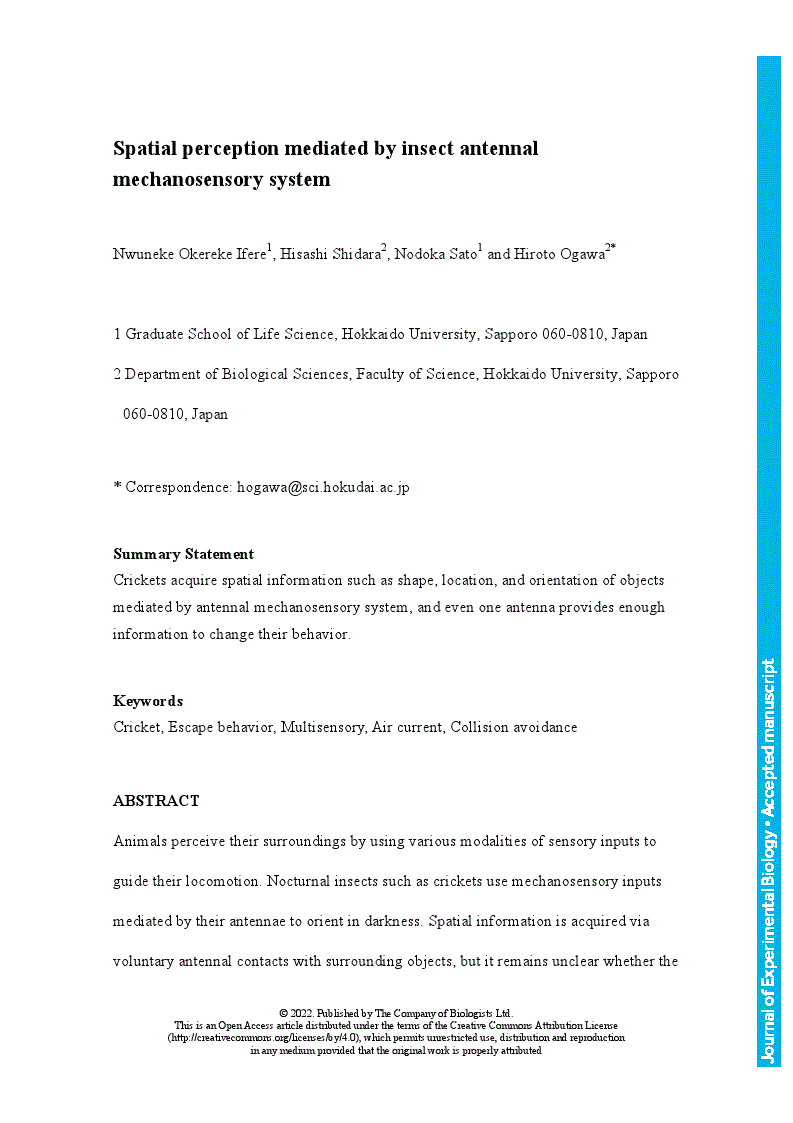Animals perceive their surroundings by using various modalities of sensory inputs to guide their locomotion. Nocturnal insects such as crickets use mechanosensory inputs mediated by their antennae to orient in darkness. Spatial information is acquired via voluntary antennal contacts with surrounding objects, but it remains unclear whether the insects modulate behaviors mediated by other sensory organs based on that information. Crickets exhibit escape behavior in response to a short air-puff, which is detected by the abdominal mechanosensory organs called cerci and is perceived as a “predator approach” signal. We placed objects of different shapes at different locations with which the cricket actively made contact using its antenna. We then examined the effects on wind-elicited escape behavior. The crickets changed their movement trajectory in response to nearby objects like walls so that they could avoid collision with these obstacles even during the cercal-mediated behavior. For instance, when a wall was placed in front of the crickets so that it was detected by one antenna, the escape trajectory in response to a stimulus from behind was significantly biased toward the side opposite the wall. Even when the antenna on the free side without the wall was ablated, this collision avoidance was also observed, suggesting that the mechanosensory inputs from one antenna detecting an object edge would be sufficient to perceive the location of obstacle in front. This study demonstrated that crickets were able to use the spatial information acquired with their antennal system to modify their behavior mediated by other sensory organs.
Spatial perception mediated by insect antennal mechanosensory system
- Award Group:
- Funder(s): Japan Society for the Promotion of Science
- Award Id(s): 16H06544
- Funder(s):
Currently Viewing Accepted Manuscript - Newer Version Available
- Split-screen
- Views Icon Views
- Open the PDF for in another window
-
Article Versions Icon
Versions
- Version of Record 24 February 2022
- Accepted Manuscript 24 January 2022
- Share Icon Share
-
Tools Icon
Tools
- Search Site
Nwuneke Okereke Ifere, Hisashi Shidara, Nodoka Sato, Hiroto Ogawa; Spatial perception mediated by insect antennal mechanosensory system. J Exp Biol 2022; jeb.243276. doi: https://doi.org/10.1242/jeb.243276
Download citation file:
Advertisement
2023 JEB Outstanding Paper Prize shortlist and winner

The JEB Editors are delighted to announce the shortlisted authors for the 2023 JEB Outstanding Paper Prize. Read the winning paper - Tiny spies: mosquito antennae are sensitive sensors for eavesdropping on frog calls - by Hoover Pantoja-Sanchez and Brian Leavell from Ximena Bernal's lab at Purdue University, USA.
JEB Science Communication Workshop for ECRs

If you’re an early-career researcher interested in science communication and are attending the SEB Annual Conference in Prague this summer, come a day early and join the JEB Editors at a sci comm workshop to learn the key writing skills needed to promote your research to a broad audience beyond your peers (1 July at 14.30-17.30). Places are limited to 24 attendees, and applicants should apply through the SEB registration page by 30 April 2024.
Bridging the gap between controlled conditions and natural habitats in understanding behaviour

Novel technologies enable behavioural experiments with non-model species, in naturalistic habitats and with underexplored behaviours. In their Commentary, Scholz and colleagues discuss how to obtain a deeper understanding of the natural ecology and lifestyle of study animals.
How a macrourid fish remains buoyant at depths it should be unable to reach

Fish with swimbladders should not be capable of descending below 7200m, but when Alan Jamieson and Todd Bond spotted a macrourid fish at 7259m, they knew they had seen something miraculous. Working with Imantes Priede, they reveal that the swimbladder of a 1 kg fish could hold 37.9 g of oxygen, sufficient to offset the weight of the fish's bones, and take 221-440 days to fill, which is plausible because it takes years for the fish to descend to such depths.
ECR Workshop on Positive Peer Review

Are you an ECR looking for tips on how to write concise, astute and useful manuscript reviews? If so, join the JEB Editors at a 2-hour JEB-sponsored Workshop on Positive Peer Review at the Canadian Society of Zoologists annual meeting in Moncton on 9 May 2024 at 13.00-15.00. There are 25 spaces for ECRs and selection is first come, first serve. To sign up, check the ECR Workshop box when you register for the CSZ meeting.



